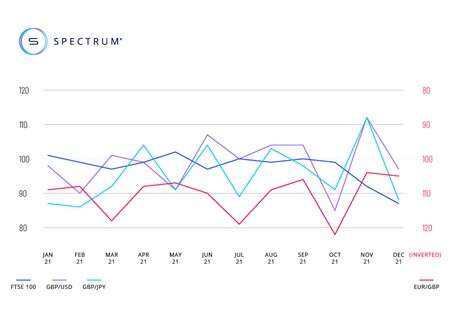
- SERIX for FTSE 100 reaches record bearish territory of 87
- British pound also loses investor confidence
- Retail investor sentiment positive on IBEX, MIB and NASDAQ
Spectrum Markets, the pan-European trading venue for securitised derivatives, has published its SERIX sentiment data for European retail investors for December (see below for more information on the methodology), revealing that of all investible equity indices the UK’s FTSE 100 experienced the most long-selling and short-buying activity.
Since the SERIX value on the FTSE 100 stood at 100 in September 2021, representing an equal balance of buying and selling, the curve sloped sharply into bearish territory in the months thereafter, finally reaching a value of 87 in December, the lowest monthly value for the index since the SERIX was introduced as a benchmark. In contrast, positive investor sentiment can be observed in the Italian MIB 40 index (101), the Spanish IBEX 35 (104) or America’s NASDAQ 100 (103).
At the same time, the British pound also lost investor confidence. Here, the SERIX value for the GBP/USD currency pair fell from 112 in November to 97 in December, which also indicates a bearish investor sentiment. A similar trend can be seen for sentiment around the currency pairs GBP/JPY and GBP/EUR.
Looking at the SERIX data for the top three underlying markets, the NASDAQ 100 and DAX 40 were relatively unchanged at 103 and 99 respectively. Meanwhile the S&P 500 rose slightly, from 97 to 98, while remaining in the bearish zone overall.
A lot of things have come together in the UK: Brexit, which took effect in 2021, increased trade costs, leading to a decline in trade volume and relocation of company headquarters. The loss of EU freedom of movement drew workers away, further increasing production and distribution costs. There is a national shortage of lorry drivers, but also of care workers and of workers in the food processing industry, leading to supply bottlenecks. In addition, the UK has also been hit hard by the global supply chain crisis and the associated price rises and, finally, Omicron dampened hopes of recovery.
“Overall, it seems retail investors simply did not see much in the way of encouraging signs in the UK market at the end of the year and – on the contrary – even see it as overvalued, which is illustrated by the numerous bearish positions on the FTSE 100 index. Investors also do not seem to consider the slight recovery of the FTSE to be sustainable in the long-term or sufficient cause for optimism. Alternatives such as the Spanish IBEX or the Italian MIB currently seem to be more convincing to Index investors,” explains Michael Hall, Head of Distribution at Spectrum Markets.
During December, 72.5 million securitised derivatives were traded on Spectrum Markets, with 37.2% of trades taking place outside of traditional hours (i.e. between 17:30 and 9:00 CET). 83.2% of the traded derivatives were on indices, 9.8% on currency pairs, 5.4% on commodities, and 1.6% on equities, with the top three traded underlying markets being DAX 40 (24.1%), NASDAQ 100 (17.8%), and S&P 500 (14.6%).

Calculating SERIX data
The Spectrum European Retail Investor Index (SERIX), uses the exchange’s pan-European trading data to shed light on investor sentiment towards current development in financial markets.
The index is calculated on a monthly basis by analysing retail investor trades placed and subtracting the proportion of bearish trades from the proportion of bullish trades, to give a single figure (rebased at 100) that indicates the strength and direction of sentiment:
SERIX = (% bullish trades – % bearish trades) + 100
Trades where long instruments are bought and trades where short instruments are sold are both considered bullish trades, while trades where long instruments are sold and trades where short instruments are bought are considered bearish trades. Trades that are matched by retail clients are disregarded. (For a detailed methodology and examples, please visit this link).


